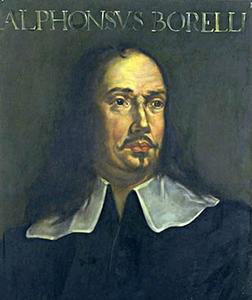<Back to Index>
- Mathematician Giovanni Alfonso Borelli, 1608
- Painter Jan Maurits Quinkhard, 1688
- President of Finland Kaarlo Juho Ståhlberg, 1865

Giovanni Alfonso Borelli (Pisa January 28, 1608 - December 31, 1679) was a Renaissance Italian physiologist, physicist and mathematician. He contributed to the modern principle of scientific investigation by continuing Galileo's custom of testing hypotheses against observation. Trained in mathematics, Borelli also made extensive studies of Jupiter's moons and, in microscopy, of the constituents of blood. He also used microscopy to investigate the stomatal movement of plants, and undertook studies in medicine and geology. During his career, he enjoyed the protection of Queen Christina of Sweden, which sheltered him from the attacks from the Italian authorities suffered by Galileo.
Giovanni Borelli was born January 28, 1608 in Castel Nuovo, Italy, a village on the outskirts of Naples. He was the son of Spanish infantryman Miguel Alonso and a local woman named Laura Porello (alternately Porelli or Borelli.)
Borelli eventually traveled to Rome to study, matriculating in mathematics. Sometime before 1640 he was appointed Professor of Mathematics at Messina. In the early 1640s, he met Galileo Galilei in Florence. While it is likely that they remained acquaintances, Galileo rejected considerations to nominate Borelli as head of Mathematics at the University of Pisa when he left the post himself. Borelli would attain this post in 1656. It was there that he first met the Italian anatomist Marcello Malpighi.
Borelli and Malpighi were both founder-members of the short-lived Accademia del Cimento, an Italian scientific academy founded in 1657. It was here that Borelli, piqued by Malpighi's own studies, began his first investigations into the science of animal movement, orbiomechanics. This began an interest that would continue for the rest of his life, eventually earning him the title of the Father of Biomechanics. Borelli's involvement in the Accademia was temporary and the organization itself disbanded shortly after he left.
Borelli returned to Messina in 1668 but was quickly forced into exile for suspected involvement in political conspiracies. Here he first became acquainted with ex-Queen Christina of Sweden who had also been exiled to Rome for converting to Catholicism. Borelli lived the rest of his years in poverty, teaching basic mathematics at the school of the convent where he had been allowed to live. He never saw the publication of his masterwork, De Motu Animalium (On the Movement of Animals) as it was published posthumously, financed by Christina and his benefactors at the convent.